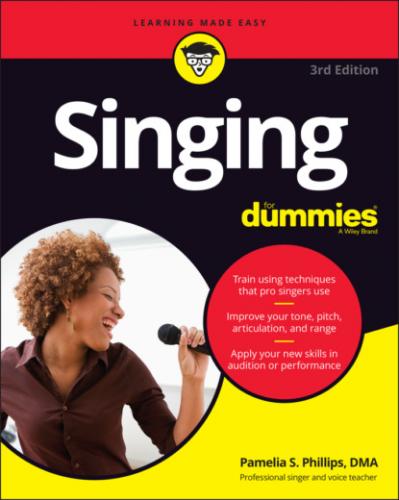Beyond This Book
In addition to what you’re reading in the print or e-book, you can check out some extra goodies and reference them when you want, check out the Cheat Sheet at www.dummies.com and search for “Singing For Dummies Cheat Sheet.” You can also find the audio files of the example tracks at http://www.dummies.com/go/singingfd3e.
Where to Go from Here
If you have no singing experience, you may want to start with Chapter 1 and work your way through the chapters in order. However, this book is designed to allow you to jump in anywhere you want and start swimming through information that’s completely understandable. If you have some singing experience, choose whatever chapter appeals to you. You may have to refer to other chapters occasionally if you missed a definition, but otherwise, you’re free to roam the chapters at your own pace and in any order. As you work through the exercises in this book, you want to have the basic technical skills of breathing (see Chapter 4) and tone (see Chapters 5 and 6) readily available. If you find yourself struggling, you may want to go straight to Chapter 3 to make sure that you have proper singing posture.
Part 1
Exploring Singing Basics
IN THIS PART …
Find out about different voice types and figure out which category fits your voice.
Understand that great posture can get your body lined up and ready to sing your best.
Discover the importance of air moving in and out of your body to keep the glorious sounds coming out.
Focus on tone, which allows you to improve on the sounds you’re already making or tweak your tone a little if your engine knocks rather than hums.
Chapter 1
Preparing to Sing
IN THIS CHAPTER
So you’re curious about singing. Whatever musical background and experience you have or don’t have, this book has something to offer you. The book contains great exercises and online tracks that allow you to hear the exercise and sing along. If you’re a beginner, welcome aboard. You can find out all kinds of cool info about singing in this book. This chapter provides an overview of all the great stuff you can encounter in the book.
Singing is one of the coolest means of expression out there. Singing well is about knowing how to work the parts that create the sound for singing. The chapters that you encounter in the book outline what you need to know in just the right sequence. You don’t have to read them in the order written to get what you need. Some of the later chapters may be a little difficult if you don’t have any singing experience. The only way to know is to jump right in and start reading on whatever topic interests you.
What You Want to Know Right from the Beginning
Before you choose the date for your first big concert or recital, you want to find out about singing. The first part of this book provides you with the big picture.
Determining your voice type
Singers usually are eager to determine their voice type because they want a category to belong to. You may have heard of the categories of singers:
Soprano: Higher female voice
Mezzo: Lower female voice
Tenor: Higher male voice
Bass: Lower male voice
If you aren’t sure which one applies to your voice, explore Chapter 2. You can find explanations of what makes a soprano differ from a mezzo, or a tenor differ from a bass. You don’t have to figure out your voice type today, but you can explore the chapter so you know what to listen for as you sing.
Locating the notes on the staff
Voice types are probably easier to figure out if you know where to find the notes on a musical staff. (See Figure 1-1 in this chapter.) The names of the notes are A, B, C, D, E, F, and G. Those notes repeat across the piano.
The treble clef spaces correspond to the notes F, A, C, and E. Beginning on the bottom of the staff and going up, the notes spell face. You can use sentences to remember the other notes. Again, starting on the bottom line and moving up, the notes on the lines of the staff are E, G, B, D, and F, letters that begin the words of the sentence Every good boy does fine.
For the bass clef, the spaces are A, C, E, and G, the letters that begin the sentences All cows eat grass or All cars eat gas. The lines in the bass clef are G, B, D, F, and A, which correspond to Good boys do fine always. If you prefer animals, then use Great big dogs fight animals.
If I say that a singer’s range is Middle C to High C, I have to use ledger lines to notate those two notes because they’re not within the five-line staff. Ledger lines are extra lines added above or below the staff for notes that are higher or lower than the notes on the staff. When you find Middle C in Figure 1-1, you can see the extra line added below the staff. The easiest way to find Middle C on the piano is to look at the brand name printed on or above the lid covering the keys. If you find that brand name, the C right in the middle of that name, or just to the left, is usually Middle C.
© John Wiley & Sons, Inc.
FIGURE 1-1: Locating notes on the staff.
